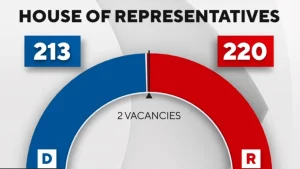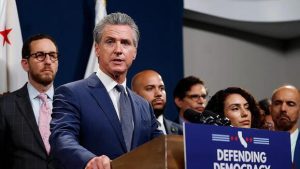The US election race 2026 is rapidly taking shape as one of the most consequential midterm contests in recent American history. Scheduled for November 3, 2026, these elections will determine control of both chambers of Congress during President Donald Trump’s second term, with all 435 House seats and 35 Senate seats up for grabs. Political strategists from both major parties recognise that the outcome will fundamentally shape the final two years of the Trump presidency and set the stage for the 2028 presidential contest.
 Also Read: US election race 2026
Also Read: US election race 2026
Other: Modi Tejashwi Claim
National Republicans have launched aggressive preparations focused on retaining their narrow congressional majorities. Currently holding a 220-215 advantage in the House of Representatives, Republicans can afford to lose only two seats while maintaining control. The Republican National Committee has confirmed plans for an unprecedented “midterm convention” ahead of the races, designed to showcase legislative achievements and mobilize the party’s base. White House officials report extensive involvement in candidate selection and messaging development, representing a significant departure from previous midterm cycles.
Democratic Mobilization and Strategic Countermoves
Democrats face a challenging electoral landscape but are mounting sophisticated campaigns to reclaim congressional power. To win a House majority in the US election race 2026, Democrats need to gain a net of three seats—a mathematically achievable but politically demanding objective. Democratic National Committee Chair Ken Martin has emphasized the importance of maintaining permanent campaign operations, stating that the party will not wait until closer to election day to begin mobilization efforts.
The Democratic Party’s strategy focuses on capitalizing on traditional midterm dynamics, where the president’s party typically loses congressional seats. Current polling data from late October 2025 shows Democrats maintaining a slender two-percentage-point advantage in generic congressional ballot testing, with 45.2 percent supporting Democratic candidates compared to 43.2 percent favoring Republicans. However, political analysts caution that these margins remain within typical polling error ranges, suggesting the US election race 2026 remains highly competitive.
Senate Battleground Taking Shape
The Senate landscape presents unique challenges for both parties in the US election race 2026. Of the 33 regular Class 2 seats and two special elections, Republicans currently hold 20 seats while Democrats defend 13. Democrats face particular vulnerability in Michigan, where incumbent Gary Peters is not seeking reelection, and Georgia, where Senator Jon Ossoff must defend his seat in a state Trump narrowly won in 2024.
Eight senators have already announced retirement plans—four from each party—creating open-seat contests that typically draw competitive primaries. Maine’s Republican Senator Susan Collins faces what analysts consider one of the most competitive races, given the state’s Democratic-leaning electorate. Additional special elections will fill seats vacated by Marco Rubio, who became Secretary of State, and J.D. Vance, who became Vice President, adding further complexity to the US election race 2026 Senate battleground.
Foreign Policy Debates Intensify Political Discourse
Foreign policy considerations are assuming unprecedented prominence in the US election race 2026, breaking from historical patterns where midterm elections focus primarily on domestic economic issues. Multiple international challenges—including ongoing tensions with China, relationships with NATO allies, Middle East conflicts, and immigration policy—have become central campaign themes for both parties.
Republicans are emphasizing President Trump’s “America First” approach, promising to prioritize national interests over multilateral commitments. Campaign messaging focuses on economic nationalism, renegotiating trade agreements, and taking hardline stances on immigration enforcement. GOP strategists calculate that Trump’s foreign policy vision resonates with working-class voters who feel globalization has disadvantaged American workers.


Redistricting Battles Add Wild Card Factor
Mid-decade redistricting efforts have emerged as a crucial variable that could significantly impact the US election race 2026 outcomes. Several Republican-controlled state legislatures have pursued or completed congressional map redraws aimed at maximizing partisan advantage. Missouri recently enacted new boundaries transforming a solidly Democratic district into a Republican-leaning seat, while North Carolina Republicans adjusted maps to strengthen their congressional delegation.
Democrats have threatened counter-redistricting measures in states they control. California legislators drafted plans to eliminate multiple Republican districts, though implementation requires overcoming constitutional hurdles. Virginia announced intentions to redraw congressional boundaries before the midterms, while Illinois and Maryland governors have kept redistricting options open. Legal experts estimate these combined redistricting battles could shift dozens of seats, introducing significant uncertainty into US election race 2026 predictions.
Swing Voter Groups Could Determine Outcomes
Political pollsters have identified several demographic groups that could prove decisive in the US election race 2026. Young Hispanic men, who swung toward Republicans in 2024 by ten percentage points, represent a critical swing constituency that both parties are aggressively courting. Economic concerns, particularly regarding inflation and employment opportunities, appear to be primary motivators for these voters.
Young voters overall, despite traditionally low midterm turnout rates, represent an increasingly significant proportion of the electorate. Recent data suggests younger voters are trending back toward Democrats, though enthusiasm gaps remain concerning for party strategists. The growing gender and education divides continue reshaping coalition dynamics, with college-educated voters increasingly favoring Democrats while non-college-educated voters trend Republican.
Additionally, undecided and low-propensity voters—those who participate inconsistently in elections—could determine narrow races throughout the US election race 2026. Republicans acknowledge they have become “the party of low-propensity voters,” launching specialized mobilization initiatives to ensure supporters turn out even without Trump on the ballot. Democrats face similar challenges activating their coalition in a midterm environment.
Looking Ahead to November 2026
As the US election race 2026 accelerates toward its November 3 climax, both parties face the monumental task of energizing supporters, persuading persuadable voters, and executing sophisticated ground operations across hundreds of competitive districts. The stakes extend far beyond partisan control of Congress, encompassing fundamental questions about America’s domestic priorities and international role.
Primary elections spanning from early 2026 through summer will determine the final candidate fields, with several high-profile contests already generating intense interest. Gubernatorial races in 39 states and territories will further complicate the electoral landscape, potentially reshaping state-level power dynamics that influence everything from redistricting to presidential campaign infrastructure.



